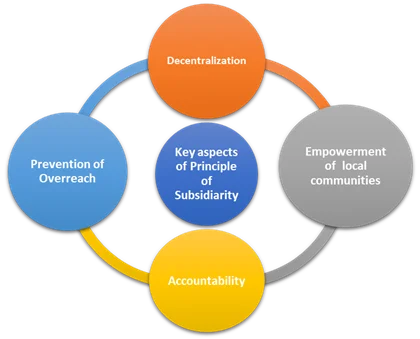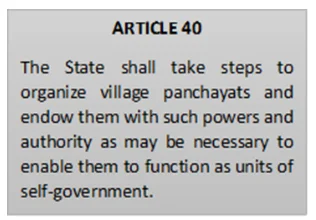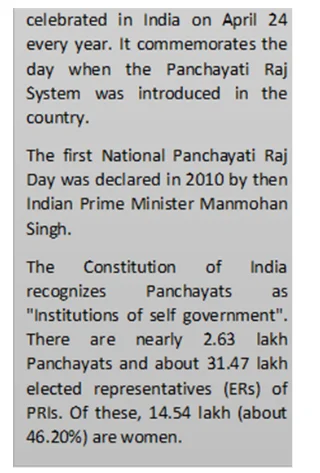Panchayati Raj is a vital local self-governance system in rural India, aimed at promoting grassroots democracy and empowering communities. Established through the 73rd Constitutional Amendment in 1992, it features a three-tier structure that facilitates local governance at the village, block, and district levels. This system is designed to enable effective decision-making and local development, following the principle of subsidiarity, which advocates for decentralization. Various committees have significantly shaped its evolution and structure.
Panchayati Raj in India: Historical Evolution and Key Committees for Decentralized Governance
Historical Roots and Constitutional Significance
- Introduction to Panchayati Raj: Panchayati-Raj is a local self-governance system in rural India, with the term “Panchayati-raj” signifying “rule by five.”
- Historical Roots: It is rooted in the Ancient political history of the Indian subcontinent, where five elder villagers made decisions concerning the village’s upkeep and growth.
- Constitutional Framework: Post-independence, the Panchayati Raj framework was given constitutional status through the 73rd constitutional amendment in 1992, featuring a three-tier administrative structure aimed at rural development.
- Objectives of Panchayati Raj: Its objective is to foster local self-governance at the district, zonal, and village levels, while also promoting grassroots democracy, empowering rural communities, and facilitating local development and administration.
- Empowering the people present at the lowest level with the devolution of powers is based on the principle of Subsidiarity.

Enroll now for UPSC Online Course
- Principle of Subsidiarity
- The principle of subsidiarity is a political concept that emphasizes decentralization and local decision-making in governance.
- It suggests that matters should be handled by the smallest, lowest, or least centralized competent authority rather than a higher or more central authority.
- The devolution of powers to PRIs and Municipalities by State governments is also based on this principle.
Panchayati Raj Evolution
The history of Panchayat Raj in Modern India can be categorized into distinct periods when viewed analytically:
- British Period: Under British rule, village panchayats lost their autonomy and grew weaker.
- Emergence of Local Institutions: However, Representative local institutions began to develop in 1870, largely due to Mayo’s resolution in 1870, which expanded their powers and responsibilities.
- Royal Commission on Decentralization: Local self-governance gained momentum with the appointment of the Royal Commission on Decentralization in 1907, chaired by C.E.H. Hobhouse.
- The commission recognized the importance of village panchayats.

-
- Montagu-Chelmsford Reforms: Later on, the Montagu Chelmsford reforms of 1919 transferred local government to the provinces.
- Post-Independence Period: After the Indian Constitution came into effect, Article 40 mentioned Panchayats, and granted State legislatures the authority to legislate on matters related to local self-government.
- Opposition to Panchayat Inclusion: There was opposition to the inclusion of panchayats in the Constitution, primarily from B.R. Ambedkar, who saw them as a caste-based institution and a tool for exploiting marginalized classes.
- Constitutional Recognition: Eventually, panchayats found their place in the Constitution under Article 40 of the Directive Principles of State Policy.

- Post-Independence Development Initiatives:
- Post-Independence Initiatives: Following India’s independence, the Community Development Programme (CDP) in 1952 and the National Extension Service (NES) in 1953 were initiated.
- These programs encountered challenges, such as bureaucracy apathy, political interference, and lack of community participation.
- Balwant Rai Mehta Committee: In January 1957, a committee led by Balwant Rai G Mehta was formed to review and enhance the CDP and NES.
- Rajasthan pioneered Panchayati Raj in 1959 based on this committee’s recommendations, with other States like Andhra Pradesh adopting it later.
- Constitutional Amendment: In 1992, the 73rd Constitutional Amendment Act was enacted, formalizing Panchayati Raj institutions, which came into effect on April 24, 1993, celebrated as National Panchayati Raj Day.
- Post-Independence Initiatives: Following India’s independence, the Community Development Programme (CDP) in 1952 and the National Extension Service (NES) in 1953 were initiated.
Various Committees Related to Panchayati Raj
| S.No | Name of the Committee | Major recommendations of the Committee |
| 1. | Balwant Rai Mehta Committee, 1957 |
|
| 2. | Ashok Mehta Committee, 1977
|
|
| 3. | G V K Rao Committee, 1985
|
|
| 4. | L M Singhvi Committee, 1986 |
|
| 5. | Thungon Committee, 1988 |
|
| 6. | Gadgil Committee, 1988 |
|
Enroll now for UPSC Online Course
| Must Read | |
| Current Affairs | Editorial Analysis |
| Upsc Notes | Upsc Blogs |
| NCERT Notes | Free Main Answer Writing |
Conclusion
The journey of Panchayati Raj has been shaped by several influential committees, each contributing valuable recommendations to enhance local governance.
- These committees emphasized the need for a decentralized system with elected representatives and reserved seats for marginalized communities.
- By fostering local participation and empowering rural populations, Panchayati Raj plays a crucial role in India’s development and democracy. Its continued evolution reflects the commitment to effective self-governance and community empowerment in rural areas.
Sign up for the PWOnlyIAS Online Course by Physics Wallah and start your journey to IAS success today!
| Related Articles | |
| Panchayati Raj in India | 73rd CONSTITUTIONAL AMENDMENT ACT, 1992 |
| LOCAL SELF-GOVERNANCE IN INDIA | The Montagu-Chelmsford Reforms |

 GS Foundation
GS Foundation Optional Course
Optional Course Combo Courses
Combo Courses Degree Program
Degree Program











